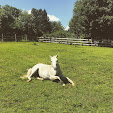The movie opens with a very old rainforest sprite explaining to her young apprentice, Crysta that humans were all wiped out centuries ago after a volcano eruption caused by Hexxus, a spirit of total destruction who is now safely trapped in a baobab tree. (Foreshadowing! Foreshadowing!) But Crysta is smarter; she has seen humans hanging out near the rainforest and learns about their true nature from a bat called Batty Koda who has a radio in his brain that was installed by evil, evil research scientists. Batty's song "Batty Rap," unabashedly condemns cosmetic and cigarette experiments on animals, making the animal experiments in The Secret of NIMH sound like an amusement park.
Two scenes later, the humans accidentally cut down the baobab tree that had imprisoned Hexxus, setting him free to sing a song called "Toxic Love" about his new mission — to destroy the rainforest through humans' greed and their expensive leveler. As the leveler cuts down trees, the artists appear to have run out of non-blood red colors. Surprisingly, the trees do not sing about their destruction. Then again, 1990s kids had other movies in which non-sentient beings sang about their suffering (say, The Brave Little Toaster or Toy Story).
Hexxus, who looks like a cross between the large winged demon in Fantasia and the black smoke from a broken down diesel truck, looms over the whole rainforest, destroying large sections of the forest. Meanwhile, the forest sprites (played by miniature white yuppies and college students) and a human who was shrunk to sprite size by Crysta, Zac, fret about what to do. While some of the sprites have magical powers, they apparently cannot grow trees or shrink the leveler. It isn't until near the end of the movie that the wise old sprite gives all the other sprites little pieces of her magical energy and tells Crysta that there is magic in every living thing the forest. After that, well, you can easily guess how the movie ends. Hexxus is trapped in a new magic tree. Zac gets returned to his normal size. We don't see him go on to join international Greenpeace, but I'm sure the writers thought about it.
Now, I consider myself very pro-Earth. I grew up in the "save the rainforest" era, during which schoolchildren received a steady diet of pro-rainforest books, movies, and TV shows. I think we were required under federal law to learn that "x square feet of rainforest are destroyed every minute" and that rainforests have a diversity of photogenic birds, frogs and monkeys. My brothers old Zoobooks (magazines about wild animals published through the San Diego zoo) added to the pro-Earth sentiment with their strongly worded essays about how lots of mean people are thoughtlessly destroying endangered animals' habitats, hunting, buying fur coats, etc. but you can make a difference and prevent tigers/elephants/lions/rainforest monkeys from becoming extinct.
But I don't think movies like Ferngully that shout the "everything in nature except humans = good; humans = heartless scum" philosophy are the way to engender pro-Earth sentiment. Nature is not a fairy tale, and most of the world's remaining undeveloped land isn't as pretty as the rainforest. And writing about the mean things people do to the environment without elaborating about changes people can make every day (like recycling cans and bottles) just leaves people feeling pessimistic and/or useless.
While there has been a brief rebound of environmentalism under the name "green" in response to global warming, I'm not sure how easy it is to teach children compared to the "save the rainforest" movement. Perhaps I'm wrong. But I don't think it would be a bad idea to bring the rainforest back into the picture without singing smoke clouds and ex-lab bats.

No comments:
Post a Comment